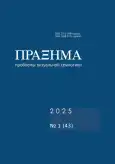Известный трактат Томаса Гоббса «Левиафан, или Материя, форма и власть государства церковного и гражданского» (1651) не только представляет собой обширный политический труд, но и включает множество тематик, посвящённых природе человека, языку и теологии. Особого интереса заслуживает тема демонологии, которую Гоббс рассматривает в своем opus magnum. Важность рассмотрения идей демонологии обосновывается спецификой контекста Англии XVII века, где разворачивается диспут о роли дьявола и демонологии. При обсуждении темы демонологии следует отметить, что внимание заслуживает не только сам текст, но и фронтиспис, написанный Абрахамом Боссом для Гоббса. Основанием для обращения к фронтиспису являются два следующих утверждения: во-первых, для христианской традиции Левиафан относится к сфере демонического, во-вторых, данный образ имеет богатую историю и включает в себя разные смыслы. Таким образом, в статье рассматривается следующий вопрос: каков потенциал фронтисписа «Левиафана» как визуального источника в интерпретации идей Томаса Гоббса о демонологии?Во-первых, обращение к фронтиспису «Левиафана» позволяет нам увидеть, как визуальные составляющие этого образа согласуются с политическими идеями Гоббса. Например, меч и жезл в одних руках «большого человека» (μάκρος ἄνθρωπος’) передают идею о том, что суверен реализует светскую и духовную власть одновременно. Другим важным примером выступает наличие в теле Левиафана маленьких людей, которые знаменуют собой общественный договор каждого с каждым перед лицом смертного Бога. Специфика Левиафана подчёркивается ссылкой на ветхозаветную книгу Иова, в которой встречаются описания этого образа.Во-вторых, демонстрируется то, какие функции несёт в себе изображение в политической философии «Левиафана». Посредством анализа текста Гоббса мы выделяем по крайней мере три функции изображения: удержание образа в памяти; возможность почитания; страх подданных перед насильственной смертью от рук суверена за непослушание.В-третьих, несмотря на то, что фронтиспис не содержит явных демонологических образов, а критика демонологии Гоббсом заключается в его философии языка, риторике и толковании текстов Библии, изображение Левиафана выступает в статье в качестве визуального источника идей Гоббса о демонологии. Вновь обращаясь к телу Левиафана, состоящему из маленьких людей, отмечается ассоциативная связь множества с множественностью дьявола в средневековой демонологии. Множество, не имеющее ранее субъектности в естественном состоянии, превращается в народ, а волю последнего выражает суверен. В этом отношении наблюдается противопоставление единому как благу и множеству как злу. В конце концов отмечается, что сам взор подданных направлен на голову Левиафана. Подданные, смотря на мир «глазами» суверена (через его «оптику»), не допускают наличия демонологических образов, однако принимают образ суверена, наводящего на них страх.
 9-37
9-37


 38-69
38-69


 70-92
70-92


 93-116
93-116


 117-137
117-137


 138-167
138-167


 168-180
168-180


 181-199
181-199












